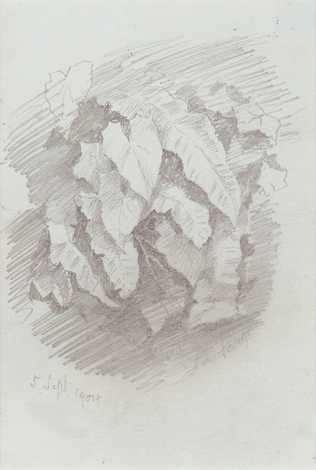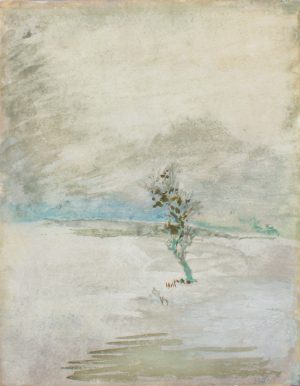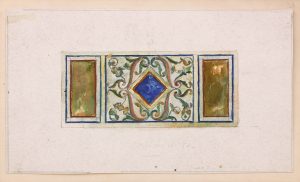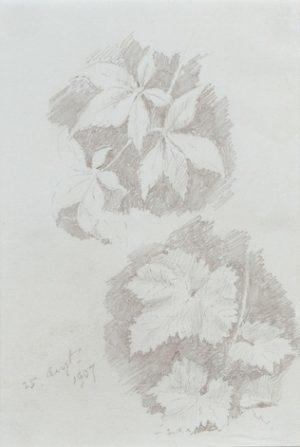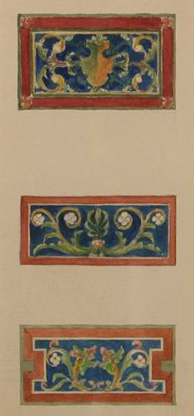John La Farge (1835-1910)
Painter, engraver, muralist, illustrator, author, lecturer, and stained glass artist, John Frederick Lewis Joseph La Farge is one of the most important American artists and cultural figures of the 19th Century. He was born in 1835 in New York City to wealthy French Roman Catholic parents. As a youth he received his first art instruction from his grandfather, a miniaturist who had studied architecture. He attended St. John’s College (later Fordham) in New York and Mount Saint Mary’s College in Maryland, from which he graduated in 1853. While working for a law firm in New York, La Farge studied painting with the French Hudson River School artist, François Régis Gignoux. In 1856, La Farge traveled to Europe where he studied briefly with the French master Thomas Couture. Back in America, in 1858, La Farge rented a room in the new Tenth Street Studio Building in New York. On the advice of his friend, architect Richard Morris Hunt, he decided to travel to Newport, Rhode Island to study painting in the studio of Hunt’s older brother, William Morris Hunt. But inspired by Newport’s beautiful environment and to satisfy his own aesthetic, he left Hunt’s studio to become the first artist to paint landscapes in the open air. “Newport,” La Farge wrote, “a place quite separate and removed from all artistic influences, good or bad, made an ideal retreat for individual study.” It was in Newport during the 1860s and early 1870s that La Farge produced the first impressionist experiments painted in America. From 1861 to 1873 the artist lived mainly in Newport. During this time, La Farge attended anatomy lectures in Boston given by physician-artist William Rimmer. During this period also, the artist combined an interest in Japanese art and in the work of the British Pre-Raphaelites to produce a series of illustrations for various books and magazines that anticipated the Art Nouveau movement. In 1876 La Farge accepted a commission to work with architect Henry Hobson Richardson on the interior decoration of Trinity Church in Copley Square, Boston. This marked the beginning of La Farge’s career as a decorative artist, after which he received numerous domestic, public and ecclesiastical commissions. With his work at Trinity, especially his murals, La Farge is considered to have single-handedly initiated the American Renaissance movement. His interest in medieval arts led him to experiment with stained glass through which he came to invent opalescent glass. In 1879 La Farge established a window manufacturing company in New York and began to receive the first of hundreds of commissions, public and private. Display of his work in glass at the Paris International Exhibition of 1889 earned him appointment to the French Legion of Honor. In 1886 La Farge traveled to Japan with his friend Henry Adams, with whom he also traveled to the South Seas in 1890-1891 and to France in 1899. La Farge recorded these trips in paintings, later publishing illustrated books of his adventures. He wrote a number of books and articles and lectured widely on various subjects, including his pioneering art criticism. His artwork was exhibited widely throughout the United States and in France. When La Farge died in 1910 he was eulogized by the art critic and biographer Royal Cortissoz as: “our sole ‘Old Master’, our sole type of genius that went out with the Italian Renaissance.” La Farge’s artworks are found in numerous museum collections, churches, and universities all across America and in France.
Fern Leaves, 1904
by John La Farge (1835-1910)
| Medium | Drawing |
| Medium Detail | Pencil on paper |
| Dimensions | 5 x 3 ½ inches |
| Signed Location | Signed, lower right; Dated, lower left |
| Date Created | 1904 |
| Provenance | From a sketchbook that La Farge maintained over many years of visits to the summer house of Sir William Van Horne in Thousand Isles, Canada. Van Horne was the director of the Canadian Pacific Railway and an avid collector of La Farge’s work. |
| Comments | Inscribed and dated lower left |
1 in stock
Contact Us About This Piece

